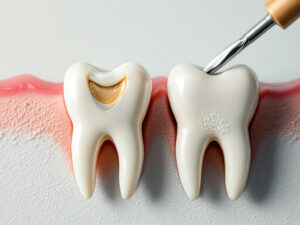Understanding Root Canal Treatment
Understanding the essentials of root canal treatment can help you make informed decisions about your dental care. Here, you’ll learn the purpose of root canals and the signs that may indicate you need one.
Purpose of Root Canals
Root canals are common procedures designed to save your natural teeth by removing infected pulp to prevent further damage. This dental treatment is required when the pulp inside a tooth becomes inflamed or infected, often due to decay, trauma, or repeated procedures on the tooth (Cleveland Clinic).
The procedure cleans, disinfects, fills, and seals the tooth to eliminate bacteria and prevent reinfection. Millions of teeth are saved each year through this method, allowing individuals to maintain a natural smile, enjoy their favorite foods, and reduce the need for ongoing dental work (AAE).
Signs You Might Need a Root Canal
You may hesitate to visit the dentist, but recognizing the symptoms indicating a root canal is important for ensuring your long-term oral health. Signs that you might need this procedure include:
| Symptom | Description |
|---|---|
| Persistent Pain | Ongoing tooth pain that doesn’t go away |
| Swelling | Swelling in the gums around the affected tooth |
| Sensitivity | Increased sensitivity to hot or cold, even after the source is removed |
| Boils on Gums | Pus or a boil formation on the gums may indicate infection |
| Darkening Tooth | Discoloration of the tooth, which can signify pulp death |
If you experience any of these symptoms, it is advisable to consult your dentist for a proper evaluation. Early intervention can prevent further complications and may save your tooth. For more detailed insights on recognizing these symptoms, visit our page on signs you need a root canal. Recognizing the necessity for a root canal might feel daunting, but understanding the facts can help alleviate your concerns and guide you towards the right treatment.
The Root Canal Procedure
Duration and Process
When you visit your dentist for a root canal, it’s essential to understand the duration and the steps involved in the treatment. The root canal procedure usually takes about 60 to 90 minutes, although some cases may require more than one visit for completion.
The key steps in the root canal procedure include:
- Diagnosis: Your dentist will assess your symptoms and determine if a root canal is necessary, often prompted by signs you might need a root canal, such as persistent pain or sensitivity.
- Anesthesia: Local anesthesia is administered to ensure you do not feel pain during the procedure.
- Access Opening: A small opening is made in the crown of the tooth to access the pulp chamber.
- Pulp Removal: The infected or damaged pulp tissue is carefully removed.
- Cleaning and Shaping: The empty pulp chamber and root canals are cleaned and shaped.
- Filling: The canals are filled with a biocompatible material to prevent reinfection.
- Sealing: The access opening is sealed, and you may receive a temporary filling.
For a detailed breakdown of these steps, you can check out our article on root canal procedure steps.
Success Rate and Longevity
Root canals are known for being both effective and long-lasting. Most root canal treatments succeed and can last for many years, often a lifetime.
The cumulative survival rates for teeth after root canal treatment are as follows:
| Years Post Treatment | Survival Rate (%) | Endodontic Success Rate (%) |
|---|---|---|
| 10 | 97 | 93 |
| 20 | 81 | 85 |
| 30 | 76 | 81 |
| 37 | 68 | 81 |
These statistics demonstrate not only the longevity of treated teeth but also the high success rates of your treatment. When complications do arise, they are often connected to underlying factors such as the health of the surrounding tissues (NCBI).
It’s crucial to maintain good oral hygiene and schedule regular dental check-ups to improve the longevity and success of your root canal treatment. For more information on effective aftercare, visit our article on root canal recovery time.
Debunking Root Canal Myths
There are many misconceptions surrounding root canal treatment that often lead to unnecessary fear. Understanding the facts versus the myths can help you make informed decisions about your dental health.
Myth 1: Root Canal Pain
One prevalent myth is that root canal treatment is extremely painful. In reality, advancements in dental technology and effective anesthetic techniques ensure that patients typically experience no more discomfort than that of a routine cavity filling. Endodontists are specialists in pain management, making the procedure as comfortable as possible (American Association of Endodontists).
Here’s a quick comparison of pain perception between common dental procedures:
| Procedure | Pain Level |
|---|---|
| Cavity Filling | Low |
| Root Canal Treatment | Low |
| Tooth Extraction | Moderate to High |
Myth 2: Root Canal Illness Connection
Another misconception is the belief that root canals cause illness. This myth has been debunked through modern research, which indicates that root canal treatment does not result in systemic health problems. In fact, studies show that patients who undergo multiple endodontic treatments may have a 45% reduced risk of cancer (American Association of Endodontists). This myth likely arose from outdated beliefs and has no scientific backing.
Myth 3: Natural Tooth Preservation
Many people believe that extracting a tooth is preferable to having a root canal. However, this is not the case. Preserving your natural tooth through root canal treatment is often the best option. Root canals have a high success rate, with many treated teeth lasting a lifetime. Alternatives such as bridges or implants may not match the longevity or natural function of an intact tooth (American Association of Endodontists).
Here’s a look at the longevity of different options:
| Dental Option | Expected Lifespan |
|---|---|
| Root Canal-Treated Tooth | Lifetime |
| Dental Bridge | 10-15 years |
| Dental Implant | 10-15 years |
By debunking these myths, you can feel more confident in discussing root canal treatment with your dentist and understanding its importance for maintaining your dental health. If you notice any symptoms that may indicate the need for a root canal, such as pain or sensitivity, consider reading about signs you need a root canal for more information.
More Root Canal Myths Addressed
In addressing misconceptions surrounding root canal treatment, it’s important to clarify how these procedures work and identify the signs that indicate you might need one.
Myth 4: Root Canal Procedure Details
A common misconception is that root canal procedures involve removing the roots of the tooth. In reality, during a root canal treatment, the pulp — the innermost part of the tooth — is removed, while the roots remain intact (American Association of Endodontists). This distinction is crucial because the roots house the nerves that help anchor the tooth in place. Retaining the roots while removing the infected pulp allows for preserving the natural structure of the tooth and preventing further complications.
Myth 5: Root Canal Indicators
Another myth is that a throbbing toothache is the only indicator that you may need a root canal. In fact, a tooth may require this treatment even when there is no noticeable pain. Endodontists can conduct specific tests to assess whether the pulp is infected or damaged. Symptoms indicating that you might need a root canal can vary significantly and include:
| Symptoms Indicating Need for Root Canal |
|---|
| Persistent tooth pain |
| Sensitivity to hot or cold that lingers |
| Discoloration of the tooth |
| Swelling and tenderness in nearby gums |
| A recurring pimple on the gums |
If you are experiencing any of these signs, it may be worth consulting a dental professional. They can provide further evaluation and determine if you require root canal treatment. For a deeper understanding of root canals, explore our articles on what is a root canal and the specific steps and timeline involved in the root canal procedure as well as how long it typically takes (how long does a root canal take).
Understanding these facts will help you make informed decisions about your dental health and alleviate any fears or misunderstandings about root canal treatment.
Alternatives to Root Canal Treatment
If you are experiencing persistent tooth pain, sensitivity, or infection symptoms, you may want to know your options for relief. While root canal treatment is a common solution for save a damaged tooth, there are several alternatives you could consider. Below are three main alternatives: direct pulp capping, pulpotomy, and tooth extraction.
Direct Pulp Capping
Direct pulp capping is a treatment option designed to protect the pulp of a tooth that has been exposed due to decay or injury. In this procedure, a biocompatible material is placed directly over the exposed pulp to promote healing and preserve the tooth. This approach is often considered when the pulp is still healthy or only slightly inflamed.
This treatment can be more conservative than a root canal, allowing you to save your natural tooth while preventing further complications. The success of direct pulp capping depends greatly on the condition of the pulp and how quickly the treatment is administered. For more details on what root canals entail, you can refer to what is a root canal.
Pulpotomy
Pulpotomy involves the removal of the diseased portion of the pulp while leaving the healthy part intact. It is generally performed on primary teeth in children but can also be applicable to adults under specific conditions. After the affected tissue is removed, the remaining pulp is treated and sealed, preserving the tooth.
This procedure can serve as a temporary solution while allowing for further evaluation of the tooth’s health. In certain cases, a pulpotomy might defer the need for a complete root canal. To understand the exact steps of a root canal treatment, check out our guide on root canal procedure steps.
| Treatment Option | Description | Ideal Candidates |
|---|---|---|
| Direct Pulp Capping | Protects exposed pulp, promotes healing | Healthy pulp, minimal damage |
| Pulpotomy | Removes diseased pulp, preserves healthy | Young patients, specific conditions |
Tooth Extraction
When other treatments are no longer viable, tooth extraction may be the final option for extreme tooth damage or irreversible decay. This is often considered a last resort when the tooth cannot be saved through any other means. Following an extraction, options for tooth replacement include dental implants, bridges, or dentures.
Tooth extraction can lead to gaps, altering your bite and possibly causing other dental issues over time. Therefore, discussing all possible alternatives, including the consideration of root canal treatment, is crucial. For insights about comparing root canals and extractions, read about root canal vs tooth extraction.
In summary, understanding the alternatives to root canal treatment can help you make an informed decision regarding your dental health. Always be sure to consult with your dentist to determine the best course of action based on your specific circumstances.
Dental Health and Root Canal Recovery
Post-Procedure Discomfort
After undergoing a root canal procedure, you might experience mild pain and discomfort for a few days. This can usually be managed effectively with over-the-counter pain medications. If the discomfort lasts longer than a week, it is advisable to schedule a follow-up appointment with your dentist to rule out any complications.
Most patients find the experience less painful than anticipated, especially since dentists administer local anesthesia to ensure comfort during the treatment. The discomfort often arises from the tooth’s condition prior to the procedure, which the treatment is aimed at fixing. Painful root canals are largely considered a myth, as modern techniques and pain management ensure minimal pain during and after the treatment (American Association of Endodontists).
Here is a table summarizing expected post-procedure discomfort:
| Discomfort Level | Duration | Pain Management |
|---|---|---|
| Mild Pain | 1-3 Days | Over-the-counter pain medications |
| Moderate Pain | Up to 1 Week | Follow-up with dentist recommended |
| Severe Pain | More than 1 Week | Immediate dental consultation |
Importance of Good Oral Hygiene
Maintaining good oral hygiene after your root canal is crucial for a smooth recovery and long-term dental health. Follow these practices to ensure optimal healing:
- Brush and Floss Regularly: Continue your routine of brushing twice a day and flossing daily. This helps keep the treated area clean and free from bacteria.
- Avoid Hard Foods: Be cautious with hard or sticky foods, as they may disturb the treated area or the temporary filling that may be placed.
- Stay Hydrated: Drink plenty of water, which helps maintain saliva flow and can contribute to healing.
- Follow Your Dentist’s Instructions: Adhering to any specific care guidelines provided by your dentist is critical for recovering successfully.
For more detailed information about recovery and aftercare, consult our article on root canal home care aftercare. Taking these precautionary measures can significantly enhance your recovery process, ensuring that your root canal is a success and your natural teeth are preserved effectively. For any additional concerns or questions about root canal treatment, check our root canal FAQ.










